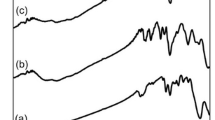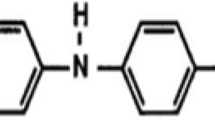Abstract
The present work aims at studying electrical relaxations in silver–polyaniline nanocomposites using dielectric spectroscopy. The nanocomposites of dodecylbenzenesulfonic acid-doped polyaniline (PANI) with different concentrations of silver nanoparticles (~6–12 nm) are synthesized by simple wet-chemical route. The temperature dependence of dc conductivity in all the samples follows three-dimensional variable range-hopping conduction mechanism. The loss factor, after having subtracted the dc contribution, shows a relaxation peak which simultaneously attributes to the frequency dispersion in conductivity spectra. The observed dielectric relaxation is well fitted by the Havriliak–Negami function, and the fitting parameters are determined. The temperature dependence of characteristic relaxation frequency and dc conductivity is in line with each other and bear a resemblance to the origin of dc transport and dielectric relaxation in these systems. The temperature behavior of the relaxation strength confirms that an exclusive hopping conduction of polarons in the disordered PANI matrix can be considered as the origin of the observed electrical properties of the systems. Further, the self-similar behavior of the real part of normalized ac conductivity, within the measured temperature range, also confirms the above inferences. The variation of frequency exponent with temperature suggests that ac conduction is due to the correlated barrier hopping of polarons which strongly affected by the dispersion of silver nanoparticles within the PANI matrix.











Similar content being viewed by others
References
Manners I (2001) Putting metals into polymers. Science 294:1664–1666. doi:10.1126/science.1066321
Liu Y, Drew MB, Liu Y, Cao F (2014) A comparative study of Fe3O4/polyaniline composites with octahedral and microspherical inorganic kernels. J Mater Sci 49(10):3694–3704. doi:10.1007/s10853-014-8079-5
Athawale AA, Bhagwat SV, Katre PP (2006) Nanocomposite of Pd–polyaniline as a selective methanol sensor. Sens Actuators B 114(1):263–267. doi:10.1016/j.snb.2005.05.009
Choudhury A (2009) Polyaniline/silver nanocomposites: dielectric properties and ethanol vapour sensitivity. Sens Actuators B 138(1):318–325. doi:10.1016/j.snb.2009.01.019
Müller CD, Aurélie F, Nina R et al (2003) Multi-colour organic light-emitting displays by solution processing. Nature 421(6925):829–833. doi:10.1038/nature01390
Tian S, Baba A, Liu J et al (2003) Electroactivity of polyaniline multilayer films in neutral solution and their electrocatalyzed oxidation of β-nicotinamide adenine dinucleotide. Adv Funct Mater 13(6):473–479. doi:10.1002/adfm.200304320
Tseng RJ, Huang J, Ouyang J, Kaner RB, Yang Y (2005) Polyaniline nanofiber/gold nanoparticle nonvolatile memory. Nano Lett 5(6):1077–1080. doi:10.1021/nl050587l
Patil DS, Shaikh JS, Pawar SA et al (2012) Investigations on silver/polyaniline electrodes for electrochemical supercapacitors. Phys Chem Chem Phys 14(34):11886–11895. doi:10.1039/c2cp41757j
Faisal M, Khasim S (2013) Broadband electromagnetic shielding and dielectric properties of polyaniline-stannous oxide composites. J Mater Sci 24(7):2202–2210. doi:10.1007/s10854-013-1080-y
Epstein AJ, Lee WP, Prigodin VN (2001) Low-dimensional variable range hopping in conducting polymers. Synth Met 117(1–3):9–13. doi:10.1016/S0379-6779(00)00531-2
Bober P, Trchová M, Prokeš J, Varga M, Stejskal J (2011) Polyaniline–silver composites prepared by the oxidation of aniline with silver nitrate in solutions of sulfonic acids. Electrochim Acta 56(10):3580–3585. doi:10.1016/j.electacta.2010.08.041
Neelgund GM, Hrehorova E, Joyce M, Bliznyuk V (2008) Synthesis and characterization of polyaniline derivative and silver nanoparticle composites. Polym Int 57(10):1083–1089. doi:10.1002/pi.2445
Chatterjee S, Garai A, Nandi AK (2011) Mechanism of polypyrrole and silver nanorod formation in lauric acid–cetyl trimethyl ammonium bromide coacervate gel template: physical and conductivity properties. Synth Met 161(1–2):62–71. doi:10.1016/j.synthmet.2010.10.035
Bober P, Stejskal J, Trchová M, Hromádková J, Prokeš J (2010) Polyaniline-coated silver nanowires. React Funct Polym 70(9):656–662. doi:10.1016/j.reactfunctpolym.2010.05.009
Blinova NV, Stejskal J, Trchová M, Sapurina I, Ćirić-Marjanović G (2009) The oxidation of aniline with silver nitrate to polyaniline–silver composites. Polymer 50(1):50–56. doi:10.1016/j.polymer.2008.10.040
Biswas S, Dutta B, Bhattacharya S (2013) Dependence of the carrier mobility and trapped charge limited conduction on silver nanoparticles embedment in doped polypyrrole nanostructures. J Appl Phys 114(14):143701. doi:10.1063/1.4824380
Stejskal J (2013) Conducting polymer–silver composites. Chem Pap 67(8):814–848. doi:10.2478/s11696-012-0304-6
Sharma M, Ambolikar A, Aggarwal S (2011) In situ synthesis of gold–polyaniline composite in nanopores of polycarbonate membrane. J Mater Sci 46(17):5715–5722. doi:10.1007/s10853-011-5525-5
Afzal AB, Akhtar MJ (2010) Effect of inorganic silver nanoparticles on structural and electrical properties of polyaniline/PVC blends. J Inorg Organomet Polym 20(4):783–792. doi:10.1007/s10904-010-9405-2
Cao Y, Smith P, Heeger AJ (1992) Counter-ion induced processibility of conducting polyaniline and of conducting polyblends of polyaniline in bulk polymers. Synth Met 48(1):91–97. doi:10.1016/0379-6779(92)90053-L
Shreepathi S, Holze R (2005) Spectroelectrochemical investigations of soluble polyaniline synthesized via new inverse emulsion pathway. Chem Mater 17(16):4078–4085. doi:10.1021/cm050117s
Kim Y-B, Choi J-K, Yu J-A, Hong J-W (2002) Synthesis and characterization of a non-aqueous conductive microgel coated with poly(aniline)–DBSA in a colloidal dispersion. Synth Met 131(1–3):79–85. doi:10.1016/S0379-6779(02)00172-8
Babazadeh M (2009) Aqueous dispersions of DBSA-doped polyaniline: one-pot preparation, characterization, and properties study. J Appl Polym Sci 113(6):3980–3984. doi:10.1002/app.30460
Tamboli MS, Kulkarni MV, Patil RH, Gade WN, Navale SC, Kale BB (2012) Nanowires of silver–polyaniline nanocomposite synthesized via in situ polymerization and its novel functionality as an antibacterial agent. Colloids Surf B 92:35–41. doi:10.1016/j.colsurfb.2011.11.006
Afzal A, Javed Akhtar M (2012) Effects of silver nanoparticles on thermal properties of DBSA-doped polyaniline/PVC blends. Iran Polym J 21(8):489–496. doi:10.1007/s13726-012-0053-y
Mott NF, Davis EA (2012) Electronic processes in non-crystalline materials. Clarendon Press, Oxford, p xiv
Scher H, Lax M (1973) Stochastic transport in a disordered solid. I. Theory. Phys Rev B 7(10):4491–4502
Capaccioli S, Lucchesi M, Rolla PA, Ruggeri G (1998) Dielectric response analysis of a conducting polymer dominated by the hopping charge transport. J Phys 10(25):5595
Jonscher AK (1983) Dielectric relaxation in solids. Chelsea Dielectrics Press, London, p xiii
Shreepathi S, Holze R (2006) Spectroelectrochemistry and preresonance Raman spectroscopy of polyaniline–odecylbenzenesulfonic acid colloidal dispersions. Langmuir 22(11):5196–5204. doi:10.1021/la060053f
Lee K, Heeger AJ, Cao Y (1993) Reflectance of polyaniline protonated with camphor sulfonic acid: disordered metal on the metal-insulator boundary. Phys Rev B 48(20):14884–14891
Heeger AJ (2001) Nobel lecture: semiconducting and metallic polymers: the fourth generation of polymeric materials. Rev Mod Phys 73(3):681–700
Runt JP, Fitzgerald JJ (1997) Dielectric spectroscopy of polymeric materials: fundamentals and applications. Dielectric spectroscopy of polymeric materials. American Chemical Society, Washington, DC
Wang ZH, Li C, Scherr EM, MacDiarmid AG, Epstein AJ (1991) Three dimensionality of “metallic” states in conducting polymers: polyaniline. Phys Rev Lett 66(13):1745–1748
Kremer F, Schönhals A (2003) Broadband dielectric spectroscopy. Springer, Berlin, p xxi
Press WH (1996) FORTRAN numerical recipes, 2nd edn. Cambridge University Press, Cambridge
Sakellis I, Papathanassiou AN, Grammatikakis J (2009) Effect of composition on the dielectric relaxation of zeolite-conducting polyaniline blends. J Appl Phys 105(6):5–064109
Papathanassiou AN, Sakellis I, Grammatikakis J (2007) Universal frequency-dependent ac conductivity of conducting polymer networks. Appl Phys Lett 91(12):122911–122913
Elliott SR (1990) Physics of amorphous materials. Wiley, New York
Bhattacharya S, Malik S, Nandi AK, Ghosh A (2006) Transport properties of CdS nanowire embedded poly(3-hexyl thiophene) nanocomposite. J Chem Phys 125917:174717. doi:10.1063/1.2370928
Acknowledgements
The authors are indebted to the Department of Science and Technology for the financial support under the DST-Fast Track project scheme (SR/FTP/PS-42/2009). Also, the authors acknowledge the DST-SAIF; NEHU for providing TEM facility and DST-PURSE programme, University of Kalyani for some financial support.
Author information
Authors and Affiliations
Corresponding author
Electronic supplementary material
Below is the link to the electronic supplementary material.
10853_2014_8305_MOESM1_ESM.docx
Electronic Supplementary Information (ESI) available: Analysis of FT-IR spectra; High resolution TEM image of PANIAg3. (DOCX 1661 kb)
Rights and permissions
About this article
Cite this article
Biswas, S., Dutta, B. & Bhattacharya, S. Effect of silver nanoparticle embedment on the frequency dispersive conductivity and electrical relaxation dynamics in dodecylbenzenesulfonic acid-doped polyaniline. J Mater Sci 49, 5910–5921 (2014). https://doi.org/10.1007/s10853-014-8305-1
Received:
Accepted:
Published:
Issue Date:
DOI: https://doi.org/10.1007/s10853-014-8305-1




